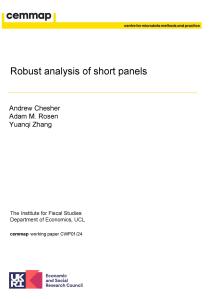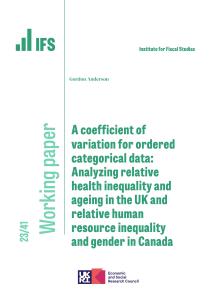We present a method to estimate preferences in the presence of unobserved choice set heterogeneity. We build on the insights of Chamberlain’s Fixed-Effect logit and exploit information in observed purchase decisions in either panel or cross-section environments to construct “sufficient sets” of choices that enable us to “difference out” the true but unobserved choice sets. We can then recover preference parameters without having to specify the process of choice set formation. We illustrate our ideas by estimating demand for chocolate bars on-the-go using individual-level data from the UK. Our results show that failing to account for unobserved choice set heterogeneity can lead to statistically and economically significant biases in the estimation of preference parameters.
This is an updated version of CEPR DP 11675.
Authors

CPP Co-Director, IFS Research Director
Rachel is Research Director and Professor at the University of Manchester. She was made a Dame for services to economic policy and education in 2021.

Research Associate University of Bristol
Alessandro is a Research Associate at the IFS, a Senior Lecturer in Economics at the University of Bristol and a Research Affiliate at CEPR IO.

Research Associate University of Zurich
Greg Crawford is a Research Associate of the IFS, a Research Fellow at the CEPR and a Professor of Economics at the University of Zurich .
Report details
- Publisher
- The IFS
Suggested citation
G, Crawford and R, Griffith and A, Iaria. (2017). Preference estimation with unobserved choice set heterogeneity using sufficient sets. London: The IFS. Available at: https://ifs.org.uk/publications/preference-estimation-unobserved-choice-set-heterogeneity-using-sufficient-sets (accessed: 19 April 2024).
Related documents
More from IFS
Understand this issue

Gender norms, violence and adolescent girls’ trajectories: Evidence from India
24 October 2022

Raising revenue from closing inheritance tax loopholes
18 April 2024

Sure Start achieved its aims, then we threw it away
15 April 2024
Policy analysis

ABC of SV: Limited Information Likelihood Inference in Stochastic Volatility Jump-Diffusion Models
We develop novel methods for estimation and filtering of continuous-time models with stochastic volatility and jumps using so-called Approximate Bayesian Compu- tation which build likelihoods based on limited information.
12 August 2014

Assessing the economic benefits of education: reconciling microeconomic and macroeconomic approaches
This CAYT report discusses the strengths and limitations of several approaches to assessing the effect of education on productivity.
14 March 2013

Misreported schooling, multiple measures and returns to educational qualifications
We provide a number of contributions of policy, practical and methodological interest to the study of the returns to educational qualifications in the presence of misreporting.
1 February 2012
Academic research

Understanding Society: minimising selection biases in data collection using mobile apps
2 February 2024

Robust analysis of short panels
8 January 2024

A coefficient of variation for ordered categorical data: Analyzing relative health inequality and ageing in the UK and relative human resource inequality and gender in Canada
21 December 2023